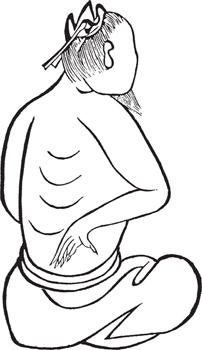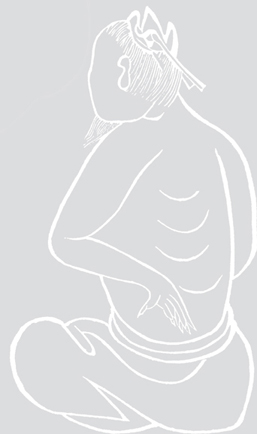
THE FIFTH BROCADE
THE SINGLE PASS WINDLASS

This chapter, as in the preceding, begins with my translation of the instructions, commentary, and correct method that were included in the Kao Lin engraving. Following the original text are Li Ching-yun’s commentary and my comments, and finally my instructions for practicing the Fifth Brocade.
The Original Text
Left and right, turn the Windlass.
Bend the head by moving it to and fro toward each shoulder, thirty-six times. Imagine the heat moving up from the lower abdomen into the Double Pass cavity and then into the brain. The nose takes in the pure air and then closes it off for a brief period.
The correct method: Bend the head as the body moves to and fro. Move the left shoulder thirty-six times and the right shoutder thirty-six times.

Author’s Comments
Note the positioning of the hands in the drawing. The back of the right palm is placed on the back near the kidneys. The left hand, hidden from view, is placed with the palm over the lower abdomen; this is the rightward style. In the leftward style of this brocade, the hands are placed exactly opposite to this.
Other than in the earlier texts, there is no reference made to this deportment, and in many contemporary works it is eliminated altogether. It may be that many later commentators felt that the Fifth and Sixth Brocades were so similar that the fifth one could be eliminated altogether. Li Ching-yun, interestingly enough, comments on only this deportment.
Li Ching-yun’s Commentary
To turn the Windlass is expressed through the hands, arms, and shoulders. First, bend the left arm and then, in unison with the shoulder, revolve the arm and shoulder leftward thirty-six times. Afterward, the right arm is likewise revolved toward the right thirty-six times. This circling is the method for mobilizing the blood. After a total of seventy-two times on the left and right sides, as before, return to closing the hands firmly and the original seated posture.
Author’s Comments
The word for windlass has been translated in the past as “pulley,” which may or may not have some justification. The Chinese characters used (representing lu lu) and the physical action of this exercise clearly suggest the idea and function of a windlass, an apparatus used in drawing a water bucket from a well. It appears from the instructions that windlass has a twofold meaning. On the one hand, the action of turning a windlass to draw a bucket of water is similar to the gesturing in the Fifth Brocade, the Single Pass Windlass, and that in the Sixth Brocade, the Double Pass Windlass. At the same time, the heat (qi) is being gathered, like filling the bucket with water at the bottom of the well, in the Single Pass Windlass. In the Double Pass Windlass, the heat qi is drawn upward, like the bucket itself as the windlass is cranked.
To date, I have yet to come across any Eight Brocades materials in English that mention these two original windlass methods, much less make a distinction between them. It seems odd that the contents of the original methods would be so easily ignored.
 Author’s Instructions
Author’s Instructions
Place the back of the right wrist and hand firmly on the lower back (kidney area). Place the left-hand palm over the lower abdomen region.
Begin by applying slight pressure on the lower abdomen with the left hand. Maintaining the pressure, circle the hand counterclockwise (first downward and to the left and then upward and to the right). The right wrist and hand are placed on the back near the kidneys and follow the motion of the left hand. Simultaneously rotate the left shoulder up and over to the right side in conjunction with the hand movements. The head is also bent left and right in unison with the hands and shoulders. In the left version of the exercise the head bends toward the left shoulder when the hands descend to the left and toward the right shoulder when the hands move upward toward the right.
When performing the movements to the right, the hands circle in a clockwise fashion and the right shoulder moves up and over to the left side, with the head bending toward the right shoulder when the hands descend to the right, and toward the left shoulder when the hands move upward toward the left.
The left and right versions are performed alternately seventy-two times (thirty-six times on each side). This exercise circulates the blood and qi throughout the entire body.
This brocade stimulates the heart.

Winding the Single Pass Windlass to the left